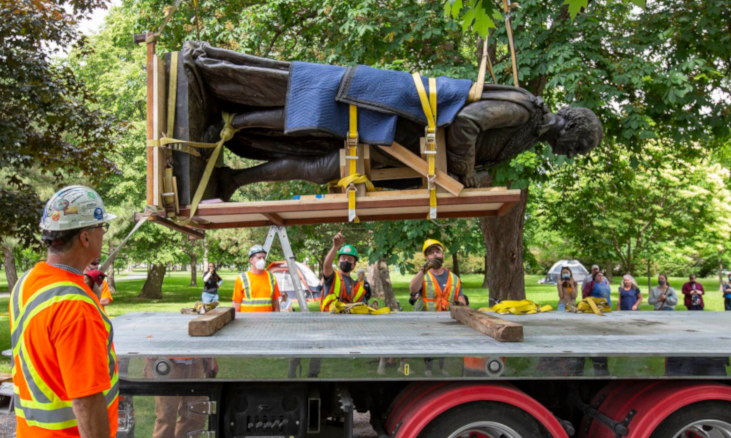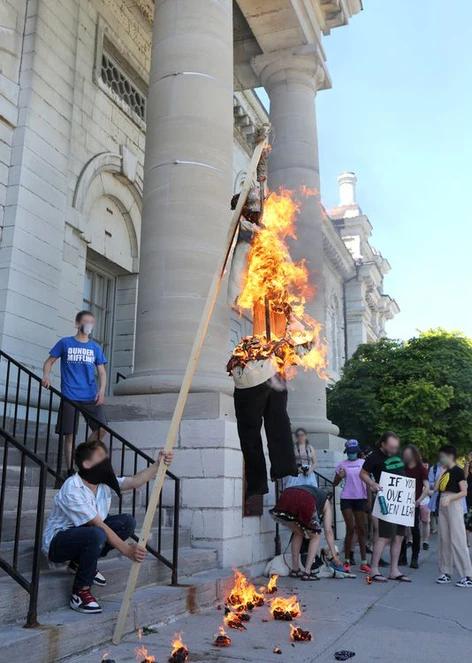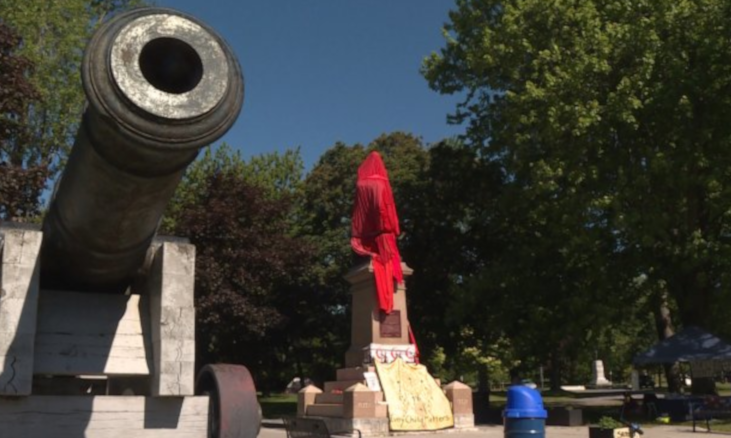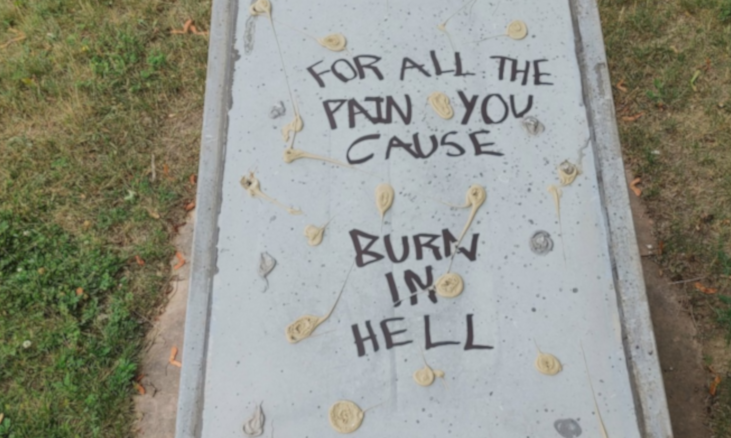Anonymous Submission to North Shore Counter-Info
A bit of background
We’ve seen quite a few statues of John A Macdonald meet their end over the past year. MacDonald no longer presides over Montreal, Charlottetown, Picton, and now, his hometown of Kingston. After years of public pressure and city council foot-dragging, Johnny Boy lays in storage in an old, musty hockey arena. Although we would have much rather liked for him to be sold as scrap to fund a Land Back camp somewhere, the thought of Canada’s first prime minister spending his days next to some rat feces and a couple of stale jockstraps is pretty funny.
But how did he get there? The statue of John A Macdonald has towered over Kingston’s City Park for like a hundred fucking years. Eventually, local Indigenous folks and anti-colonial accomplices started raising a fuss, crashing his annual birthday celebrations and occasionally vandalizing his statue. Some old men in kilts were peeved, the local newspaper published an op-ed about how the vandals should be literally tarred and feathered, and Kingston established the Sir John A Macdonald History and Legacy Working Group to offer direction to city council. After a few years of meetings, consultations, and panel discussions, their solution was to add a new plaque to “tell a more complete and inclusive account” of history. Genocide: It’s Complicated™.
The tone around John A in Kingston seemed to slightly change come late May, when 215 unmarked graves were found at Kamloops Indian Residential School. Kingstonians were once again forced to confront their complicity in celebrating the architect of the residential school system. As anti-colonial actions ramped up from coast to coast, the statue coming down one way or another seemed inevitable.
Revolution of the heart
On the evening of June 10th, local Indigenous and non-Indigenous community members met up at the John A statue at City Park. The event was organized under the banner of Revolution of the Heart: A Ceremonial Action. The group lit a sacred fire and came together in ceremony as a giant red cloth was draped over the statue. They vowed to camp out until it was taken down and replaced with a monument to commemorate the lives lost in residential schools.
Before long, more tents started popping up. A few instant shelters were raised to protect folks from the elements and fresh bannock was shared all around. The statue’s pedestal was chalked with anti-colonial messages and a tally of residential school graves, which was updated as new findings were reported. The number grew bigger each day, as news from Brandon, Lestock, Regina, and other places came in.
Local mayor and former fundamentalist Christian cult member / youth pastor Bryan Paterson inevitably showed up to give a run-of-the-mill reconciliation spiel and assure everyone that the cops wouldn’t be mobilized to clear the camp. Given the context, police enforcement would surely be a PR disaster. Attention soon turned from watching out for the cops to dealing with white nationalists and salty loyalists. These interactions were often effectively deescalated, though some did get tense. Late one night, a drunk white dude on an moped threatened to “come back with some guns,” though his threats never materialized.
Despite the occasional encounters with racists, the mood at City Park was festive and upbeat. There were daily drum circles and round dances, a constant influx of visitors and supporters, and enough donations to keep everyone fed many times over. Although most people would have probably loved to rip John A down from his pedestal in one go, the encampment provided a great opportunity for folks to gather and reconnect for the first time since the pandemic.
The joyless terrain of municipal politics
The encampment seemed to light a fire under the city’s ass. A special council meeting to debate the fate of the statue was scheduled for June 16th. On June 14th, the John A working group would meet to draft a new set of recommendations. The group drew consensus that the statue should be removed from its pedestal as soon as possible and placed in storage for until further discussions could take place.
On the day of the council meeting, around 50 people gathered at the camp to listen live. Nearly a dozen community members (including residential school and sixties scoop survivors) called in and delivered impassioned speeches about why the statue should be taken down.
Then the councilors took the floor, and it was soon apparent that listening to 13 white people debate the “good and bad” of John A’s legacy is about as fun as licking a bug zapper. Being discussed were two options: A) Leave the statue up, or B) Take the statue down. But in true sleazeball fashion, the mayor had a trick up his sleeve. He proposed a third, middle-of-the-road option: C) Place the statue at Cataraqui Cemetery next to Macdonald’s gravesite. This option had never before been made known to other councilors or the working group that was supposed to guide them in their decision-making.
Insisting that his was the only way to “bridge the divide,” Paterson eventually convinced most of the other councilors to vote in his favour. Removal of the statue was to begin a few days later. It would be put into storage until its eventual relocation to the cemetery later in the summer.
A bittersweet victory
About 150 people gathered to witness the removal of the statue. A crew of heritage masons fiddled around for hours as they tried to devise a plan to prevent John A from turning into Humpty Dumpty. A small group of loyalists milled about. Their kilts blew with the same wind that waved their British flags. The shrill sound of bagpipes was an unwelcome guest.
The vibe on our side was celebratory. Pow-wow music blasted over a speaker as people round-danced. Any progress by the masons was cheered by the crowd. After several hours, they drove a crane in front of the statue in preparation to lift it up. Two old loyalists went under the police tape and stood in its way. “Freedom of assembly!” one shouted. But their conviction was no match for some cop who shooed them away in about 30 seconds.
With that minor hiccup out of the way, the statue was strapped up and ready to go. And just like that, we had lift off! John A was off his pedestal, swinging around like a thing that swings around. The crowd went wild. Cheers erupted all around and the chorus from Steam’s “Na Na Hey Hey Kiss Him Goodbye” was chanted on repeat. The statue was slowly laid down on a flat-bed truck and driven to the aforementioned hockey arena.
To be honest, we knew the fight wasn’t over. Nobody was satisfied with the final result. It wasn’t enough to have the statue moved from the park to another location. People at the camp wanted the monument to never see the light of day, along with all other statues like it. Still, the feeling that there was now a greater potential for anti-colonial action was real, and the connections that were made at the park seemed like they would help facilitate a lot more things happening in the future.
Until next time
John A’s grave at Cataraqui Cemetery was vandalized on the night before Canada Day. His gravestone was covered in red paint and a monument that once held a plaque was decorated with graffiti that read “For all the pain you cause, burn in hell.” The plaque was already removed because it had previously been vandalized.
The cemetery is privately owned. It makes its money from families that deem it a pleasant location to set their loved ones to rest. Presumably, the organization that runs it is more concerned with satisfying its customers than fighting an annoying political battle to maintain a statue that keeps getting vandalized. The pending agreement to host the statue leaves open many possibilities to pressure the cemetery’s board of directors to call the whole thing off.
It’s evident that politicians will politic. Perhaps too much trust was placed on city officials to reach a satisfying outcome. Neo-liberalism is a helluva drug, and those who take it will often find a way to co-opt a struggle and come up with a solution that “pleases everyone.” Maybe relying on city council is a losing battle, and it might be time to take some cues from how folks in Winnipeg or Montreal dealt with their colonial statues.
Lastly, if another camp emerges, it would be great to have serious collective discussions about security and deescalation. Attacks on protest and encampments by the far-right are becoming more and more frequent. Although these events may at times seem isolated to the US, it can and does happen here. The truck attack on the Muslim family in London occurred just a few days before the encampment began. Still, it’s important to not let our fears paralyze us. Let’s hope for the best and prepare for the worst.




